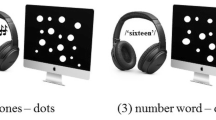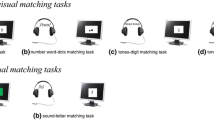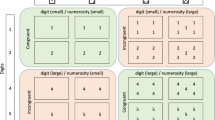Abstract
Previous research has shown that null numerosity can be processed as a numerical entity that is represented together with non-null numerosities on the same magnitude system. The present study examined which conditions enable perceiving nonsymbolic (i.e., an empty set) and symbolic (i.e., 0) representations of null numerosity as a numerical entity, using distance and end effects. In Experiment 1, participants performed magnitude comparisons of notation homogeneous pairs (both numerosities appeared in nonsymbolic or symbolic format), as well as heterogeneous pairs (a nonsymbolic numerosity versus a symbolic one). Comparisons to 0 resulted in faster responses and an attenuated distance effect in all conditions, whereas comparisons to an empty set produced such effects only in the nonsymbolic and symbolic homogeneous conditions. In Experiments 2 and 3, participants performed same/different numerosity judgments with heterogeneous pairs. A distance effect emerged for "different" judgments of 0 and sets of 1 to 9 dots, but not for those with an empty set versus digits 1–9. These findings indicate that perceiving an empty set, but not 0, as a numerical entity is determined by notation homogeneity and task requirements.





Similar content being viewed by others
Notes
Furthermore, visual inspection of the data in the symbolic block (see Figure 2, left panel) suggests that the distance effect found for comparisons to empty sets may stem from a significant linear decrease primarily explained by the RT difference between an intrapair distance of 1 and all other intrapair distances, instead of reflecting a gradual linear decrease with the increase in the intrapair distance. An intrapair distance of 1 in comparisons to null numerosity corresponds to a comparison between two semantic end-values, that is, 0 and 1. Such a comparison may be conflicting, thus resulting in longer RTs (Pinhas et al., 2015; Pinhas & Tzelgov, 2012). To examine this impression statistically, we reanalyzed both comparisons to null numerosity and other comparisons in each of the homogeneous blocks excluding an intrapair distance of 1. In each of these four conditions, we examined the significance of the linear trend to evaluate the presence of a distance effect. Comparisons to null numerosity resulted in significant linear trends in both the symbolic block, F(1, 23) = 12.48, MSE = 88.21, p = .004, η2p = .27, and nonsymbolic block, F(1, 23) = 71.12, MSE = 61.88, p < .001, η2p = .82. Similarly, significant linear trends were obtained for other comparisons in the symbolic block, F(1, 23) = 8.17, MSE = 206, p < .001, η2p = .09) and nonsymbolic block, F(1, 23) = 54.46, MSE = 371, p < .001, η2p = .48.
The error rate analyses in the same/different tasks of both Experiments 2 and 3 indicated an increase in the error rates as a function of an increase in the presented numerosity for “same” responses. These findings reflect the inaccuracy of the estimation process in larger quantities. “Different” responses rarely resulted in errors and, thus, their analyses did not result in significant effects. Accordingly, the error rate analyses revealed no speed-accuracy trade-offs or significant effects. Therefore, for the sake of brevity, they were not reported.
References
Bächtold, D., Baumüller, M., & Brugger, P. (1998). Stimulus-response compatibility in representational space. Neuropsychologia, 36(8), 731–735.
Banks, W. P. (1977). Encoding and processing of symbolic information in comparative judgments. The Psychology of Learning and Motivation, 11, 101–159.
Beran, M. J., Perdue, B. M., & Evans, T. A. (2015). Monkey mathematical abilities. The Oxford Handbook of Numerical Cognition (pp. 237–257). Oxford, UK: University Press.
Bialystok, E., & Codd, J. (2000). Representing quantity beyond whole numbers: Some, none, and part. Canadian Journal of Experimental Psychology/Revue Canadienne De Psychologie Expérimentale, 54, 117–128.
Biro, D., & Matsuzawa, T. (2001). Use of numerical symbols by the chimpanzee (Pan troglodytes): Cardinals, ordinals, and the introduction of zero. Animal Cognition, 4, 193–199.
Botvinick, M. M., Braver, T. S., Barch, D. M., Carter, C. S., & Cohen, J. D. (2001). Conflict monitoring and cognitive control. Psychological Review, 108, 624–652.
Brysbaert, M. (1995). Arabic number reading: On the nature of the numerical scale and the origin of phonological recoding. Journal of Experimental Psychology: General, 124, 434–452.
Butterworth, B., Zorzi, M., Girelli, L., & Jonckheere, A. (2001). Storage and retrieval of addition facts: The role of number comparison. The Quarterly Journal of Experimental Psychology: Section A, 54, 1005–1029.
Campbell, J. I. (1994). Architectures for numerical cognition. Cognition, 53(1), 1–44.
Campbell, J. I. D., & Metcalfe, A. W. S. (2007). Numeral format and arithmetic rules. European Journal of Cognitive Psychology, 19, 335–355.
Clearfield, M. W., & Mix, K. S. (1999). Number versus contour length in infants’ discrimination of small visual sets. Psychological Science, 10, 408–411.
Clearfield, M. W., & Mix, K. S. (2001). Amount versus number: Infants’ use of area and contour length to discriminate small sets. Journal of Cognition and Development, 2, 243–260.
Cohen, D. J. (2009). Integers do not automatically activate their quantity representation. Psychonomic Bulletin & Review, 16, 332–336.
Cohen, J. D., Dunbar, K., & McClelland, J. L. (1990). On the control of automatic processes: A parallel distributed processing account of the Stroop effect. Psychological Review, 97, 332–361.
Cohen Kadosh, R., Brodsky, W., Levin, M., & Henik, A. (2008). Mental representation: What can pitch tell us about the distance effect? Cortex, 44, 470–477.
Cohen Kadosh, R., & Walsh, V. (2009). Numerical representation in the parietal lobes: Abstract or not abstract? Behavioral and Brain Sciences, 32, 313–328.
Cooper Jr, R. G. (1984). Early number development. In Origins of cognitive skills: The eighteenth annual Carnegie symposium on cognition (pp. 157–192). Erlbaum.
Defever, E., Sasanguie, D., Vandewaetere, M., & Reynvoet, B. (2012). What can the same–different task tell us about the development of magnitude representations? Acta Psychologica, 140, 35–42.
Dehaene, S. (1992). Varieties of numerical abilities. Cognition, 44, 1–42.
Dehaene, S. (2003). The neural basis of the Weber-Fechner law: A logarithmic mental number line. Trends in Cognitive Sciences, 7, 145–147.
Dehaene, S., & Akhavein, R. (1995). Attention, automaticity, and levels of representation in number processing. Journal of Experimental Psychology: Learning, Memory, and Cognition, 21, 314–326.
Dehaene, S., & Changeux, J. (1993). Development of elementary numerical abilities: A neuronal model. Journal of Cognitive Neuroscience, 5, 390–407.
Dehaene, S., & Cohen, L. (1995). Towards an anatomical and functional model of number processing. Mathematical Cognition, 1, 83–120.
Dehaene, S., Piazza, M., Pinel, P., & Cohen, L. (2003). Three parietal circuits for number processing. Cognitive Neuropsychology, 20, 487–506.
Entel, O., Tzelgov, J., Bereby-Meyer, Y., & Shahar, N. (2015). Exploring relations between task conflict and informational conflict in the Stroop task. Psychological Research Psychologische Forschung, 79, 913–927.
Feigenson, L., Dehaene, S., & Spelke, E. (2004). Core systems of number. Trends in Cognitive Sciences, 8, 307–314.
Fias, W. (2001). Two routes for the processing of verbal numbers: Evidence from the SNARC effect. Psychological Research Psychologische Forschung, 65, 250–259.
Fias, W., Lammertyn, J., Caessens, B., & Orban, G. A. (2007). Processing of abstract ordinal knowledge in the horizontal segment of the intraparietal sulcus. Journal of Neuroscience, 27, 8952–8956.
Fischer, M. H., Mills, R. A., & Shaki, S. (2010). How to cook a SNARC: Number placement in text rapidly changes spatial-numerical associations. Brain and Cognition, 72(3), 333–336.
Fischer, M. H., Shaki, S., & Cruise, A. (2009). It takes just one word to quash a SNARC. Experimental Psychology, 56(5), 361–366.
Gallistel, C. R., & Gelman, R. (1992). Preverbal and verbal counting and computation. Cognition, 44, 43–74.
Gallistel, C. R., & Gelman, R. (2000). Non-verbal numerical cognition: From reals to integers. Trends in Cognitive Sciences, 4, 59–65.
Gebuis, T., & Reynvoet, B. (2011). Generating nonsymbolic number stimuli. Behavior Research Methods, 43, 981–986.
Gebuis, T., & Reynvoet, B. (2012). The interplay between nonsymbolic number and its continuous visual properties. Journal of Experimental Psychology: General, 141, 642648-.
Godwin, H. J., Hout, M. C., & Menneer, T. (2014). Visual similarity is stronger than semantic similarity in guiding visual search for numbers. Psychonomic Bulletin & Review, 21, 689–695.
Groen, G. J., & Parkman, J. M. (1972). A chronometric analysis of simple addition. Psychological Review, 79(4), 329–343.
Howard, S. R., Avarguès-Weber, A., Garcia, J. E., Greentree, A. D., & Dyer, A. G. (2018). Numerical ordering of zero in honey bees. Science, 360, 1124–1126.
Jeffreys, H. (1961). Theory of probability . Oxford University Press.
Kaufmann, L., Vogel, S. E., Starke, M., Kremser, C., & Schocke, M. (2009). Numerical and non-numerical ordinality processing in children with and without developmental dyscalculia: Evidence from fMRI. Cognitive Development, 24, 486–494.
Keppel, G. (1991). Design and analysis: A researcher's handbook Prentice-Hall, Inc.
Leibovich, T., & Ansari, D. (2017). Accumulation of non-numerical evidence during nonsymbolic number processing in the brain: An fmri study. Human Brain Mapping, 38, 4908–4921.
Leibovich, T., Katzin, N., Harel, M., & Henik, A. (2017). From “sense of number” to “sense of magnitude”: The role of continuous magnitudes in numerical cognition. Behavioral and Brain Sciences, 40, e164.
Leth-Steensen, C., & Marley, A. (2000). A model of response time effects in symbolic comparison. Psychological Review, 107, 62–100.
Levin, Y., & Tzelgov, J. (2016). What Klein’s “semantic gradient” does and does not really show: Decomposing Stroop interference into task and informational conflict components. Frontiers in Psychology, 7, 249.
Liszkowski, U., Schäfer, M., Carpenter, M., & Tomasello, M. (2009). Prelinguistic infants, but not chimpanzees, communicate about absent entities. Psychological Science, 20, 654–660.
Maxwell, S. E., Delaney, H. D., & Kelley, K. (2017). Designing experiments and analyzing data: A model comparison perspective (3rd ed.). Routledge.
Meck, W. H., & Church, R. M. (1983). A mode control model of counting and timing processes. Journal of Experimental Psychology: Animal Behavior Processes, 9, 320–334.
Merritt, D. J., & Brannon, E. M. (2013). Nothing to it: Precursors to a zero concept in preschoolers. Behavioural Processes, 93, 91–97.
Merritt, D. J., Rugani, R., & Brannon, E. M. (2009). Empty sets as part of the numerical continuum: Conceptual precursors to the zero concept in rhesus monkeys. Journal of Experimental Psychology: General, 138, 258–269.
Moyer, R. S., & Landauer, T. K. (1967). Time required for judgements of numerical inequality. Nature, 215, 1519–1520.
Nieder, A. (2018). Honey bees zero in on the empty set. Science, 360, 1069–1070.
Notebaert, W., Gevers, W., Verguts, T., & Fias, W. (2006). Shared spatial representations for numbers and space: The reversal of the SNARC and the Simon effects. Journal of Experimental Psychology: Human Perception and Performance, 32(5), 1197.
Nuerk, H., Iversen, W., & Willmes, K. (2004). Notational modulation of the SNARC and the MARC (linguistic markedness of response codes) effect. Quarterly Journal of Experimental Psychology Section A, 57, 835–863.
Okuyama, S., Kuki, T., & Mushiake, H. (2015). Representation of the numerosity ‘zero’ in the parietal cortex of the monkey. Scientific Reports, 5, 10059.
Pepperberg, I. M. (2006). Grey parrot numerical competence: A review. Animal Cognition, 9, 377–391.
Pepperberg, I. M., & Gordon, J. D. (2005). Number comprehension by a grey parrot (Psittacus erithacus), including a zero-like concept. Journal of Comparative Psychology, 119, 197–209.
Pinhas, M., Buchman, C., Lavro, D., Mesika, D., Tzelgov, J., & Berger, A. (2015). The neural signatures of processing semantic end values in automatic number comparisons. Frontiers in Human Neuroscience, 9, 645.
Pinhas, M., Pothos, E. M., & Tzelgov, J. (2013). Zooming in and out from the mental number line: Evidence for a number range effect. Journal of Experimental Psychology: Learning, Memory, and Cognition, 39(3), 972.
Pinhas, M., & Tzelgov, J. (2012). Expanding on the mental number line: Zero is perceived as the “smallest.” Journal of Experimental Psychology: Learning, Memory, and Cognition, 38(5), 1187–1205.
Pinhas, M., Tzelgov, J., & Ganor-Stern, D. (2012). Estimating linear effects in ANOVA designs: The easy way. Behavior Research Methods, 44(3), 788–794.
Pinhas, M., Tzelgov, J., & Guata-Yaakobi, I. (2010). Exploring the mental number line via the size congruity effect. Canadian Journal of Experimental Psychology, 64(3), 221–225.
Ramirez-Cardenas, A., Moskaleva, M., & Nieder, A. (2016). Neuronal representation of numerosity zero in the primate parieto-frontal number network. Current Biology, 26, 1285–1294.
Ratinckx, E., Brysbaert, M., & Fias, W. (2005). Naming two-digit Arabic numerals: Evidence from masked priming studies. Journal of Experimental Psychology: Human Perception and Performance, 31(5), 1150.
Robson, D. S. (1959). A simple method for constructing orthogonal polynomials when the independent variable is unequally spaced. Biometrics, 15, 187–191.
Rouder, J. N., Speckman, P. L., Sun, D., Morey, R. D., & Iverson, G. (2009). Bayesian t tests for accepting and rejecting the null hypothesis. Psychonomic bulletin & review, 16(2), 225–237.
Schneider, W., Eschman, A., & Zuccolotto, A. (2002). E-Prime: User's guide. Psychology Software Incorporated.
Semenza, C., Grana, A., & Girelli, L. (2006). On knowing about nothing: The processing of zero in single-and multi-digit multiplication. Aphasiology, 20, 1105–1111.
Shaki, S., & Fischer, M. H. (2008). Reading space into numbers–a cross-linguistic comparison of the SNARC effect. Cognition, 108(2), 590–599.
Tzelgov, J., & Ganor-Stern, D. (2005). Automaticity in processing ordinal information. In J. I. D. Campbell (Ed.), Handbook of mathematical cognition (pp. 55–67). Psychology Press.
Van Opstal, F., Gevers, W., De Moor, W., & Verguts, T. (2008). Dissecting the symbolic distance effect: Comparison and priming effects in numerical and nonnumerical orders. Psychonomic Bulletin & Review, 15, 419–425.
Van Opstal, F., & Verguts, T. (2011). The origins of the numerical distance effect: The same–different task. Journal of Cognitive Psychology, 23, 112–120.
Van Opstal, F., & Verguts, T. (2013). Is there a generalized magnitude system in the brain? Behavioral, neuroimaging, and computational evidence. Frontiers in Psychology, 4, 435.
Varma, S., & Schwartz, D. L. (2011). The mental representation of integers: An abstract-to-concrete shift in the understanding of mathematical concepts. Cognition, 121, 363–385.
Verguts, T., & Fias, W. (2004). Representation of number in animals and humans: A neural model. Journal of Cognitive Neuroscience, 16, 1493–1504.
Verguts, T., & Fias, W. (2008). Symbolic and nonsymbolic pathways of number processing. Philosophical Psychology, 21, 539–554.
Verguts, T., Fias, W., & Stevens, M. (2005). A model of exact small-number representation. Psychonomic Bulletin & Review, 12, 66–80.
Wellman, H. M., & Miller, K. F. (1986). Thinking about nothing: Development of concepts of zero. British Journal of Developmental Psychology, 4, 31–42.
Wynn, K., & Chiang, W. (1998). Limits to infants’ knowledge of objects: The case of magical appearance. Psychological Science, 9, 448–455.
Xu, F., & Spelke, E. S. (2000). Large number discrimination in 6-month-old infants. Cognition, 74, B1–B11.
Zaks-Ohayon, R., Pinhas, M., & Tzelgov, J. (2021). On the indicators for perceiving empty sets as zero. Acta Psychologica, 213, 103237. https://doi.org/10.1016/j.actpsy.2020.103237.
Acknowledgements
This study was carried out by the first author under the supervision of the second and third authors in partial fulfillment of the PhD requirements at Ben-Gurion University of the Negev. This research was supported by the Israel Science Foundation Grant no. 1799/12 awarded to the Center for the Study of the Neurocognitive Basis of Numerical Cognition, and Grant no. 1348/18 awarded to MP.
Author information
Authors and Affiliations
Corresponding author
Additional information
Publisher's Note
Springer Nature remains neutral with regard to jurisdictional claims in published maps and institutional affiliations.
Rights and permissions
About this article
Cite this article
Zaks-Ohayon, R., Pinhas, M. & Tzelgov, J. Nonsymbolic and symbolic representations of null numerosity. Psychological Research 86, 386–403 (2022). https://doi.org/10.1007/s00426-021-01515-4
Received:
Accepted:
Published:
Issue Date:
DOI: https://doi.org/10.1007/s00426-021-01515-4




